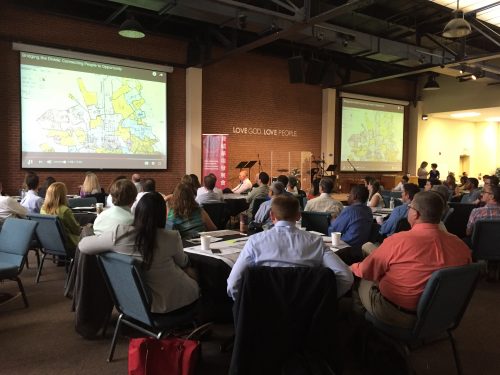U.S. Department of Transportation Convenes Massive Two-Day Design Workshop to Rethink the Vine Street Expressway


Over the sweltering days of July 14 and 15, the Vine Street Campus of the Chinese Christian Church and Center held an unlikely and motley assortment of neighbors, business owners, local workers, urban planners, designers, architects, engineers and government officials. They were all working on one big problem: the Vine Street Expressway.
The United States Department of Transportation had convened them together, with the help of the City of Philadelphia and its Office of Transportation and Infrastructure Systems (OTIS), as well as the Philadelphia Chinatown Development Corporation (PCDC), and challenged them to reconnect the communities on either side of the highway.
Vine Street local saw the most pedestrian action since perhaps 1983, when it was first constructed. Local community members conducted walking tours of the site area, from 6th to 15th Street. For some, it was the first time they had ever walked on Vine Street rather than crossed it. The challenges were clear.
Vine Street Expressway is a barrier to opportunities and connections. It was the beginning of the Chinatown community’s long and proud tradition of community activism. It is a physical danger and an abandoned and harsh wasteland of concrete and surface lots – some still owned by public entities, which had condemned homes by eminent domain long ago, but then were leased to private parking operators.
The message from the community during the two public meetings was also clear: Reconnect Us!
The final proposed renderings from the designers incorporated many of the ideas raised over the two days, including a partial recapping of the Expressway, a widening of the 10th Street pedestrian bridge to enable the development of buildings over the Expressway, and immediate solutions to diminish the overbearing presence of cars like converting one lane of traffic into a bike lane and landscaping.
This two-day design workshop was just one discussion out of decades of conversations about how to overcome the barrier of Vine Street Expressway. The 2004 Neighborhood Plan, 2013 Strategic Plan, 2003 report on Vine Street conducted by Project for Public Spaces, all preceded the charrette, addressed potential fixes, and placed Vine Street in the context of a greater neighborhood and citywide vision.
As to the future? As one organizer put it, “the rest is advocacy.” But there are exciting seed projects that will begin immediately. This summer, the Knight Foundation is supporting “10th Street Thursdays”, a weekly pop-up program on the 10th Street Plaza organized by individuals in the community. Pennsylvania Horticultural Society, with support from the Philadelphia Commerce Department, recently awarded a Neighborhood Placemaker Grant to PCDC for improvements on Vine Street and the 10th Street Plaza.
These exciting projects will implement immediate changes in the way community members and pedestrians experience one of the most heavily-trafficked intersections on the Vine Street Expressway. Later this year, look to the kickoff of the 2016 Chinatown Neighborhood Plan to continue the conversation and advocate for change!